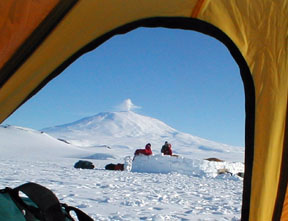
A plume rises straight above the summit of Mt. Erebus.
Mt. Erebus
At snow school we learned how to camp out, in a tent, in Antarctica. When I awoke and looked out the tent door in the morning there was mount Erebus. A huge white plume rose out of its summit crater 12,800 feet above me. The plume reminded me thatErebus is an active volcano. What a strange image, an active volcano rising above the ice of Antarctica.

Noel and I were scheduled to visit the scientists who live near the summit of Erebus and to join them on a data collecting expedition to the rim of the active crater. What I didn't know was how important our Snow school training would be to help us survive the storms that we would encounter on the mountain.
Getting There
It took the men of Shackleton's Expedition 5 days to hike from their camp near what is now McMurdo station to the summit of Mt. Erebus in 1908. They complained about the cold winds on the mountain. As a mountain climber I would love to have repeated their route, however this time I would be given a lift via helicopter to the science camp known as Lower Erebus Hut, LEH, sitting on a flat plateau 11,500 feet up the mountain.
Rapid ascent to the Lower Erebus Hut is dangerous to human bodies. In the past 20 years over a dozen people have had to be evacuated from the science camp because they suffered from altitude sickness. So now anyone going to the Lower Erebus hut for more than 8 hours is required to stop part way up the mountain at Fang Camp for 48 hours to allow their bodies to adapt to altitude. As a result, we would spend a total of 5 days on the mountain.
The reason its called Lower Erebus Hut is that there used to be an Upper hut, but in 1984 the mountain spit out volcanic bombs the size of Volkswagens that threatened the upper hut so it was abandoned for the safer and more distant lower hut.
Local mountain expert Matt Irinaga from the Berg Field Center accompanied us to the mountain. He guided us through our "Food Pull," we packed food for 3 people for 7 days, the extra food was to allow us to sit out storms. We ended up packing about 80 pounds of food, far more than we would need for a similar trip to the Sierra of California. Deb Baldwin runs the food area, it's like a supermarket but you don't pay you just write down everything that you take.
Our helicopter pilot, Barry, whisked us up to a flat campsite behind a black cliff known as Fang Ridge. The fang ridge is the rim of the old caldera of Erebus, the new cone rises far above the old caldera. Two Scott tents were set up waiting for us. Thank goodness for that. No sooner had we arrived than a strong wind sprang up, Noel reported that his bare hand on the video camera controls lost feeling in about 10 seconds, so we dove for the shelter of the tents.
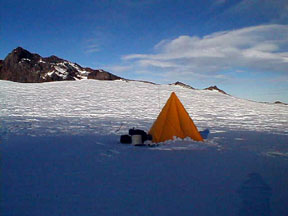
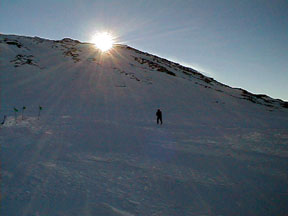
"Sunset" at Fang camp. It feels a lot colder when the sun goes
away.
Two days later the wind stopped and we emerged from our tent/prisons for our ride up to LEH. When our helicopter arrived at the hut the inhabitants sprang into frenzied activity. Our helicopter dropped us off then ferried sling loads of new gel cell lead acid batteries to E-1 a remote science station around the side of the volcano. It returned with a sling of dead batteries. At E-1, the batteries are charged by solar panels, and by a wind generator. The folk at Erebus do a good job using renewable energy sources in their work. Another crew loaded snowmobiles to make a run to install three GPS units at sites around the mountain. The GPS units record their position for several days and allow researchers to measure the mountain as it inflates and deflates.
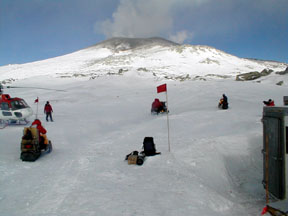
At the Hut
We were warmly welcomed to the hut and offered tea and other hot beverages. But too soon we had to go out into the rising winds and set up our tents. These Sierra Designs tents were hell to pitch but stood up well to the winds. They have 4 main poles and 7 auxiliary poles and the outer fly attaches to the main tent with a dozen fastex buckles. We had the luxury of each getting our own tent. Our huge -40 degree sleeping bags and our gear bags just about filled up the tents.
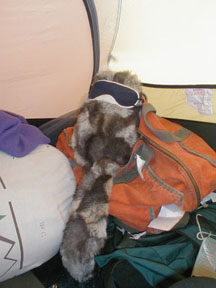
As the wind built to 40 mph and the temperature dropped to -22 F so that the windchill was -90 F the tents stayed reasonably snug. The storm blew fine snow between the my tent fly and tent, I had to go out and shovel out my tent then use large snow blockas to seal the fly to the ground on the windward side. I hoped this would keep the tent from collapsing under the snow load.
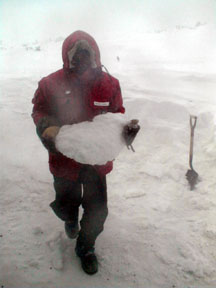
We stayed in the hut during the coldest part of the storm and got to know each other.
So you see a lot of work is being done to understand Erebus as an active volcano.
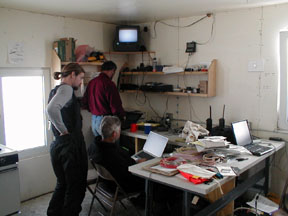
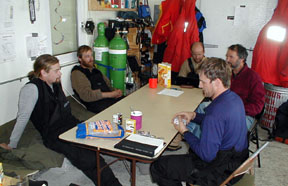
We did a live webcast from the hut during the storm. Phil suggested that we interview Jessie, Tina and Emily. It was a great suggestion. They answered the questions of children at the Exploratorium as if they had been doing public speaking for years, which it turns out they had, since they had all taught laboratory classes.
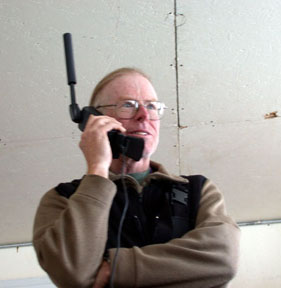

I got to look into the LEH Journal. I found that they cooked turkeys in the Maori fashion by burying them in the hot volcanic ground for two days.
That night it was really cold: -92 F windchill. Tina was worried about being cold in her tent. Noel suggested she do jumping jacks to warm up before going to sleep. She replied,"It will be a cold day in hell before I do jumping jacks." Noel quickly responded, "It is a cold day in hell."
Climbing Erebus
The next day dawned clear and less windy. Phil proved that he was the bravest man in the world, not because he studies an active volcano while camping on its side, but because he offered Noel and me two of his snowmobiles to drive up Erebus. The first time I wuld ever drive a snowmobile it would be up the; rock strewn, steep, icy, volcanic ash covered slopes of an active volcano. It felt like learning to swim by being thrown in the deep end. It was also Noels first snowmobile trip.
Matt and Jessie were our guides. Matt gave us three rules we needed to follow while riding on the volcano:
This sounded like an interesting trip. I got the feel of the two stroke engine throttle pretty fast, and got the leaning into the turns down pretty well too. I'd much rather be skiing up the mountain, but I understand that the researchers have to transport heavy equipment for which the snowmobies are more appropriate..
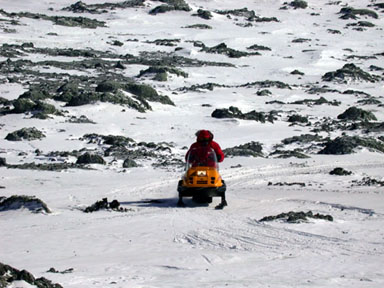
Then just as I was speeding up to blast through the first sand patch it snared Noel's machine and stopped him. I had to stop at the edge of the patch. We were both stuck. All four of us had to drag the machines out of the ash. oops! But the side slope wasn't bad and we reached the snowmobile parking area safely.
Jessie reminded us to take off our parkas for the climb to the crater rim, otherwise we would overheat and sweat. This seemed to be a strange thing to do, take off clothes to stay warm, but I knew she was right. We hiked up the steep slope stopping to admire the large volcanic bombs thrown out during past eruptions.
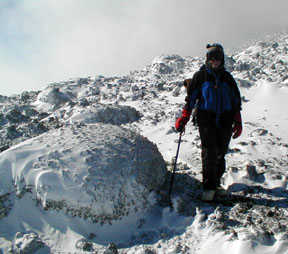
Noel and I were feeling pretty good after the slow adaptation to altitude we were forced to follow. When we reached the rim we lost our breath to the scenery not the thin air. The rim had been blasted by high winds and snow so that the rocks were covered in frost feathers.
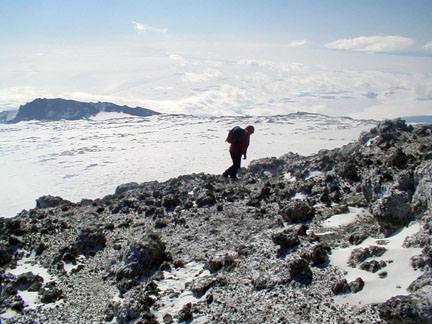
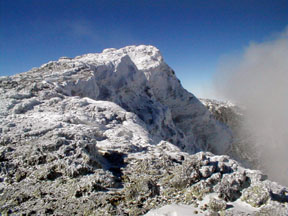
The crater rim of Erebus.
The mists opened and closed giving us glimpses of the entire crater but never revealing the entire scene at the same time. Like some geological peep show.
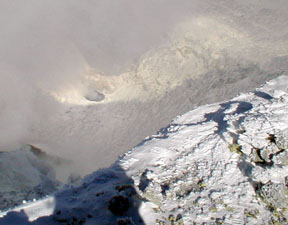
We caught glimpses of the lava lake standing out as a sharp black disk against the white snow cover on the crater floor. Vertical ice tubes ten feet across reached up the steep walls of the crater and belched steam from their tops. They reminded me of the tubes constructed by undersea worms or by termites in California. I began to think of science fiction monsters, the giant ice worms of Erebus. The crater gods were calm in our presence. Later the same day when the wind turbine repairman Joe visited the crater, it blasted out some volcanic rock and Joe decided he'd had enough of a visit to the rim Thank You. We didn't need the mythical threat of science fiction monsters, we were on the rim of an active volcano that erupts several times a day. If a blast were to shake loose the steep wall we were standing on, we would get a once in a lifetime toboggan ride down into a lava lake.
When we reached the rim we were hit by the full wind which was blowing 20 mph. With temperatures below -5 F the wind chill was pretty fierce. Noel videoed my brief statement about arriving at the rim. In under a minute, a white patch appeared on his nose... a graphic warning that frostbite was imminent. Exposed flesh was in severe danger of frostbite. As a result every square centimeter of my body was covered b clthing and I felt like I was in a spacesuit.
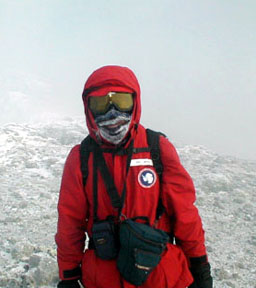
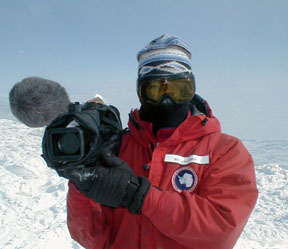
Jessie and Matt were doing science on the rim. They attached batteries to a pump to suck a known amount of air through filters to collect particles from the plume. Later Jessie would analyze these particles for traces of radioactivity which would help tell the tale of the origin of the magmas of Erebus.
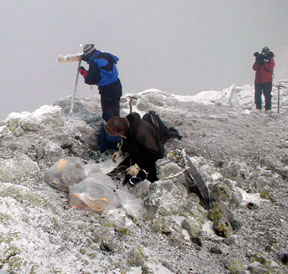
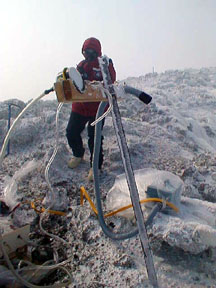
Doing science on the rim of Erebus is hard work. When Jessie has to remove her goggles to read the gauges on her instruments frost immediately forms on her eyelashes and begins to seal her eyes shut. Her hands begin to cool and lose feeling. After a couple of minutes of work with her hands in liner gloves she has to put her hands back into her mittens. Inside the mittens are chemical heater packs which restore warmth and feeling.
After an hour of data collecting we repack the gear and head down to the snowmobiles for the return trip to the hut.
The Erebus Fumarole ice towers
But there is more to see! Behind the hut there are a collection of ice towers rising above fumaroles.
Cracks in a lava flow lead to the ice towers above the fumaroles.
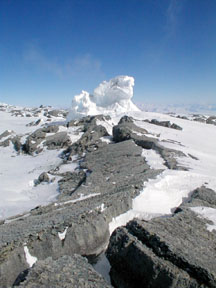
Several of the ice towers have entrances which beckon to explorers. The gasses in these towers have been tested and found to be safe for human exploration. Some fumaroles on Erebus have dangerous levels of CO2 and so expert guidance is necessary before entering the towers.
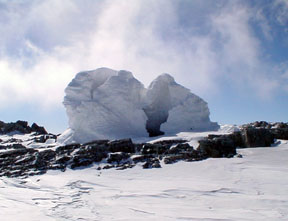
The ice towers above fumaroles are unique to places like Erebus where the air temperature never goes below freezing. The water vapor in the gasses emitted by the fumaroles freezes to the towers making them grow and change shape.
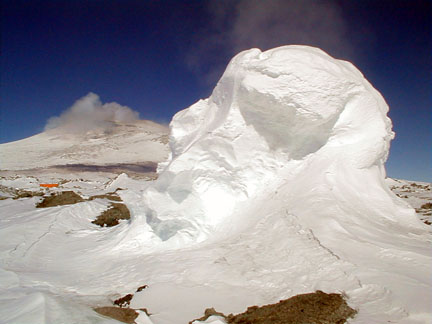
Matt lead us down into a lava tube inside one of the fumaroles. I had to squeeze through a narrow slit then do a layback on icy holds to lower myself to foothold inside the ice tower. My cameras had been outside in the -20 C air for quite a while and in the warm humid air of the fumarole they instantly iced over. Noel had kept his camera warm inside his coat and so he was able to photograph the cave.
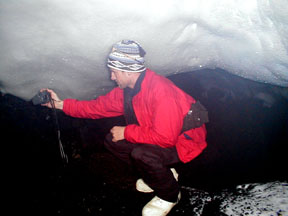
Inside the tower the light that leaked through the ice was gloriously blue. In the deepest part of the cave it became violet. The walls were lined with ice crystals, flat faces of the crystals glinted in the light like cut gemstones. It was windless and relatively warm inside. Tim the Teacher pointed out that it would be warmer sleeping in here than in our tents.
Scientists sample gasses inside the fumaroles to learn the type and amount of gas leaking out of the ground around Erebus. The insides of the fumaroles are galleries of abstract art as ice crystals and blue light combine to paint the walls.
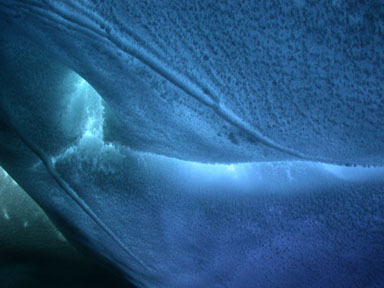
Shortly after our ice cave adventure we could hear the distinctive whup, whup, whup of the Huey helicopter approaching to take us away. I was sad to leave there is so much more to explore around here! If you go to the Lower Erebus hut make sure your visit is long enough to allow you to do several days of exploration.
In the hut journal there was that rarity, a clean limerick. This one was about a former TEA, Jean, who has a wonderful web site about her visit to the fumaroles where she studied gasses such as CO2.
A beautiful woman named Jean,
Is known as the fumarole queen,
she goes down the hole, like a CO2 mole,
and returns in a big cloud of steam.
|
Scientific Explorations with Paul Doherty |
|
10 Dec 2000 |